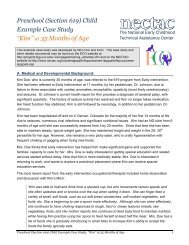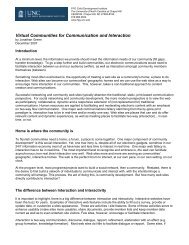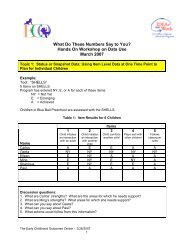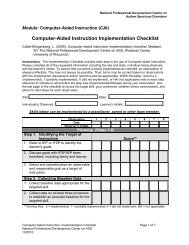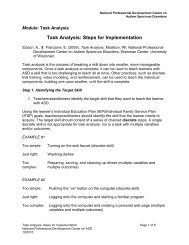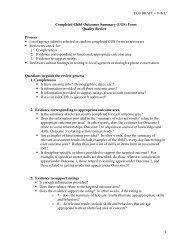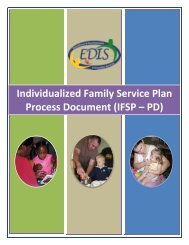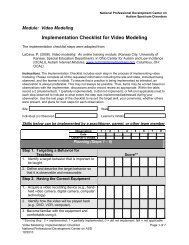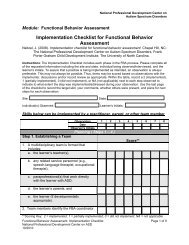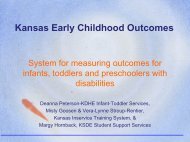Differential Reinforcement of Other Behaviors: Steps - National ...
Differential Reinforcement of Other Behaviors: Steps - National ...
Differential Reinforcement of Other Behaviors: Steps - National ...
You also want an ePaper? Increase the reach of your titles
YUMPU automatically turns print PDFs into web optimized ePapers that Google loves.
<strong>National</strong> Pr<strong>of</strong>essional Development Center onAutism Spectrum DisordersModule: <strong>Differential</strong> <strong>Reinforcement</strong> <strong>of</strong> <strong>Other</strong> <strong>Behaviors</strong>This may be done by using functional communication training, task analysis, graduatedguidance, or other kinds <strong>of</strong> direct teaching procedures such as discrete trial training. Forexample, if the replacement behavior is requesting a break, teachers/practitioners mayneed to teach the learner how to request a break using pictures or scripts.c. continuously reinforce the other/low rate/alternative/incompatible behaviors.To continuously reinforce, rapidly reinforce every instance <strong>of</strong> the replacement behavior.For example, if you are reinforcing a learner for remaining seated, providereinforcement the entire time the learner is in his/her seat.d. match the reinforcement to the function <strong>of</strong> the behavior.Because the function <strong>of</strong> a learner’s interfering behavior can change, it is important toconfirm that your intervention always matches the hypothesized function <strong>of</strong> theinterfering behavior. For example, the function <strong>of</strong> calling out behavior may initially be forattention and may later shift to escape. The DR procedure must change as well toreinforce the function <strong>of</strong> the replacement behavior (i.e., not calling out).2. If or when the interfering behavior occurs, teachers/practitioners prompt andimmediately respond to the alternative behavior by:a. prompting frequently to assure that there are enough instances <strong>of</strong> the desiredbehavior to reinforce andb. being consistent.If the desired behavior does not occur, prompt and immediately reinforce the prompteddesired behavior. For example, if the learner is calling out to get attention, prompt him toraise his hand <strong>of</strong>ten so that he can be reinforced. Prompting the desired behaviorimmediately after it occurs will increase the likelihood <strong>of</strong> the learner displaying thedesired behavior. For more information about this procedure, please see Least-to-MostPrompting: <strong>Steps</strong> for Implementation (<strong>National</strong> Pr<strong>of</strong>essional Development Center onAutism Spectrum Disorders, 2008).3. After the plan has been in place for a certain number <strong>of</strong> days as documented inthe intervention plan (see step 5.3), teachers/practitioners can alter the scheduleor reinforcement.For example, if a learner is being reinforced every hour and meets the criteria forchange according to the intervention plan, the learner may then be reinforced only twiceper day.<strong>Differential</strong> <strong>Reinforcement</strong> <strong>of</strong> <strong>Other</strong> <strong>Behaviors</strong>: <strong>Steps</strong> for Implementation Page 9 <strong>of</strong> 10<strong>National</strong> Pr<strong>of</strong>essional Development Center on ASD10/2010



